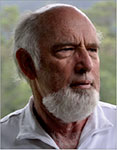Eromanga (Queensland) exploration–new concepts for an old basin
David Lowry A and David Evans BA Lowry Resources Pty Ltd
B Drillsearch Energy Ltd
The APPEA Journal 51(1) 333-358 https://doi.org/10.1071/AJ10021
Published: 2011
Abstract
Eromanga Basin exploration surged in Queensland after the discovery of the Jackson field in 1982, but has ebbed over the last 20 years. Perceived exploration risks are:
• Oil generation and migration peaked in the mid-Cretaceous before much of the anticlinal structuring, so that modern structure is an uncertain guide to Cretaceous migration paths.
• Permian coals are generally credited with sourcing most of the oil and gas in the Cooper-Eromanga Basin. In Queensland, the Permian largely drains to the southern flank and the northern flank is thought to have a high charge risk.
This study covers 100,000 km2. It used sonic logs to determine the amount of Tertiary erosion and thus allows the preparation of structure maps restored to mid-Cretaceous time. Maturity maps of the Birkhead and Poolowanna Formations were computed from a reflectance/restored temperature algorithm based on 50 wells. Source rock thickness maps and an oil expulsion model based on Pepper and Corvi (1995a, 1995b) then allowed oil expulsion to be mapped regionally.
The study produces the key results that could be expected from 3D earth modelling, but with great savings in time and money.
The study demonstrates an oil kitchen at both Poolowanna and Birkhead stratigraphic levels in the vicinity of Tanbar–1. Secondary migration losses are speculative, but modelling shows that hundreds of millions of barrels of oil from each formation have migrated west towards the Curalle ridge, north to Inland and Morney, and southeast to Mt Howitt. The Inland oil field is presently an isolated anomaly on the northwest flank of the basin, but this study suggests that further exploration in the area could be successful.

David Lowry graduated with MSc (Hons) from Auckland University in 1962 and has worked as a field geologist for GSWA, as a well site geologist, and as an exploration geologist for WAPET, Lasmo, Sagasco and Origin Energy. He also consults when the oil price is high. Particular interests are seals, geochemistry, prospect risk analysis, and hole stability. Peripheral interests have included speleology, ocean cruising and redclaw aquaculture. david@lowryresources.com.au |

David Evans is Chief Technical Officerat Drillsearch Energy Ltd. David has 25 years of upstream oil and gas exploration experience including over 15 years of experience in Australia. David joins Drillsearch from his position at Vegas Oil & Gas, a privately owned oil and gas company. Prior to this, David has held senior oil and gas exploration positions with several leading international independent oil and gas companies and technical service companies including Burren Energy, Petro-Canada International, Cairn Energy/Command Petroleum, Roxar Limited and Baker Hughes Inteq. David also spent several years in the petroleum exploration arm of AGSO (now GA). david.evans@Drillsearch.com.au |


